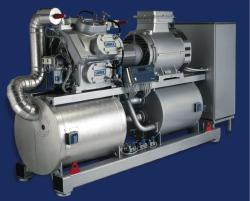New commercial opportunities for ammonia chillers

Smaller ammonia chillers on the market have cooling capacities starting at 230 kW in a small footprint. This is a York ChillPAC unit.
Ammonia has been used successfully as a refrigerant for over 150 years, but its use has traditionally been confined to large industrial refrigeration systems. DAVID EDE explores today’s opportunities for environmentally friendly ammonia to become the refrigerant of choice for air-conditioning chillers.Ammonia is a long-established refrigerant. It was one of the first to be used in mechanical refrigeration systems and continues to have universal acceptance today. There are several good reasons for this.
Extremely efficient The properties of ammonia make it extremely efficient, as less energy is required to pump the refrigerant around the system. Lubricating oil is not soluble in ammonia and can be drained from the system with relative ease. The density of ammonia is low, resulting in a condenser or evaporator having a lower operating charge for ammonia compared to other refrigerants. Ammonia systems are very flexible and can accommodate modifications and additions as project requirements change. Finally, ammonia has a very distinctive smell that makes any leakage immediately apparent, and, of paramount importance today, it has zero global warming and ozone depletion potential. With all this going for it, why has ammonia not been used more extensively for air-conditioning applications until now? The main reasons are its potential flammability and its toxicity, which necessitate certain safety precautions, and its aggressive chemical reaction when in contact with copper. Early ammonia designers also faced difficulties with refrigerant-flow control and oil return. These disadvantages were behind its fall from grace in the 1950s when the, apparently, safer CFCs became popular.
Renaissance Today, however, with advances in technologies to deal with design and safety issues, and the increasing emphasis on using refrigerants that do not deplete the ozone layer, ammonia is experiencing a renaissance. It is gradually gaining acceptance across a wide range of air-conditioning installations where specifiers are seeking the optimum in energy-efficient cooling systems that also have a minimum impact on the environment. This even includes installations in public areas such as offices, hotels, supermarkets and airport terminals where, previously, the toxicity and flammability would have precluded the use of ammonia. More compact ammonia chillers are also now entering the market, creating opportunities for smaller air-conditioning applications. York’s ChillPAC ammonia chillers, for example, have footprints no bigger than 1 m wide, are lightweight and offer cooling capacities starting at just 230 kW.
Safety So long as health and safety guidelines are adhered to, there is no reason why ammonia should not be used in any application. Responsible manufacturers include safety features as standard and are increasingly introducing models with innovative engineering to allow an exceptionally low refrigerant charge, which reduces the risks associated with a possible leak. The ChillPAC range is based around a new design of flooded evaporator, using an ammonia charge some 60% less in volume than an equivalent standard design. Air-cooled chillers on rooftops, enjoy natural ventilation to minimise the impact of potential leakage. In a plant room, the usual method of installation is to build an enclosure around the chiller to include an ammonia detection alarm, normal ventilation fan and motorised damper. Nearby would be an ammonia ‘scrubber’, bearing in mind that ammonia is highly soluble in water. Under normal conditions, air will be circulated around the plant room. If a leak is detected, the ventilation fan is switched off, the damper shut and the scrubber started. This draws the air out of the enclosure and effectively ‘washes’ it with water to absorb the ammonia. As a result, there is no danger of ammonia being vented either inside or outside the building, and there is no exposure risk for anyone entering the plant room. In the unlikely event of this happening, the waste water, with a very low concentration of ammonia, can usually be allowed to pass straight into the normal building drainage system.
Experience York has installed over a thousand packaged ammonia chillers during the last 15 years, acquiring a wealth of experience both on site and within its own research and development department. Thorough and appropriate training is, of course, essential and so that service engineers are fully conversant with ammonia handling. This expertise has led to us being approached by consultants looking at ammonia system options. We have certainly noticed a substantial increase in ammonia enquiries over the past few years.

One of four 6.6 MW ammonia chillers arrives at Heathrow Airport’s Terminal 5 project. They will provide chilled water for the air-conditioning system.
On the continent, ammonia air-conditioning systems are already commonplace. The SAS Radisson Hotel in Denmark, a high occupancy building in the heart of Aarhus town centre, has been successfully guaranteeing its guests’ comfort through the operation of water-cooled ammonia chillers for over five years. In the UK, four 6.6 MW ammonia chillers have been installed in the energy centre at Heathrow Airport to provide chilled water for the air conditioning system in the new Terminal 5 building. There is no doubt that ammonia has now been firmly re-born into air conditioning. Its future-proof potential and environmental advantages will ensure this is not just a passing vogue but represents a long term, viable alternative to HCFCs and, even, HFCs.
David Ede is director of equipment sales at York International Ltd, York House, 72 Buckingham Avenue, Slough SL1 4PN.
Related links:




